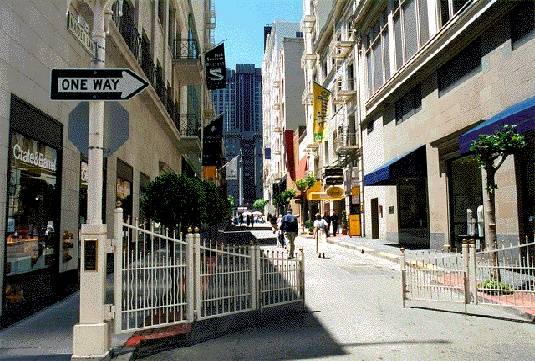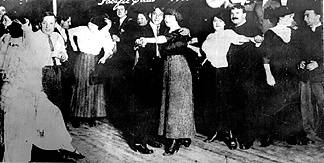San Francisco's Sleaziest Street - Yesterday and Today
Maiden Lane
Photo: Chris Carlsson
If you get tired of the posh respectability of Union Square, and find yourself with a hankering for sin, sleaze, and assorted sordid stuff, where can you go? In the words of the immortal Horace Greeley, Go west, young man. West along O'Farrell Street, that is. You'll traverse the Tenderloin District, San Francisco's scummiest neighborhood, a filth-encrusted hotbed of immorality, indecency, lewdness, corruption, and all manner of vice. (The Tenderloin got its name from the custom of paying higher salaries to police that worked in this crime-ridden area, thereby enabling them to buy choicer cuts of meat.) Eventually, if you haven't been mugged, robbed, raped, shot, or convinced to cough up a few dollars for the purpose of either acquiring some dubious mind-altering substance and/or participating in a brief, mutually-degrading physical encounter on a sagging bed in a roach-infested unfurnished room, you will reach the Mitchell Brothers' O'Farrell Theater, where your thirst for sleaze (and grotesquely overpriced drinks) can be slaked.
Actually, O'Farrell isn't really San Francisco's sleaziest street; it has to compete with cross-streets Taylor, Jones, Leavenworth, Hyde, Larkin, and the inimitable Polk, where runaway children of both sexes may be bought and sold; and with parallel thoroughfares Ellis, Eddy, Turk, and Golden Gate.
100 years ago, there was no contest; the sleaziest street in town was Morton Street, whose name has since been bowdlerized to Maiden Lane. As Herbert Asbery wrote in The Barbary Coast:
The worst cribs in San Francisco were probably those which lined both sides of Morton Street (Maiden Lane). . . These dens were occupied by women of all colors and nationalities; there were even a few Chinese and Japanese girls. And not only were the Morton Street cribs the lowest in San Francisco's red light district; they were also the most popular, partly because of the great variety and extraordinary depravity of the women to be found there, and partly because the police seldom entered the street unless compelled to do so by a murder or a serious shooting or stabbing affray. Ordinary fights and assaults were ignored...
Every night, and especially every Saturday night, this dismal bedlam of obscenity, lighted only by the red lamps above the doors of the cribs, was thronged by a tumultuous mob of half-drunken men, who stumbled from crib to crib, greedily inspecting the women as if they had been so many wild animals in cages. From the casement-windows leaned the harlots, naked to the waist, adding their shrill cries of invitation to the uproar, while their pimps haggled with passing men and tried to drag them inside the dens. If business was dull, the pimps sold the privilege of touching the breasts of the prostitutes at the standard rate of ten cents each or two for fifteen cents. But on Saturday nights some of the more popular women, who had built up a more or less regular clientele, remained in their workshops from dusk to dawn, while the pimps kept the men standing in line outside, their hats in one hand and money in the other. It was not uncommon for a Morton Street prostitute to entertain as many as eighty to a hundred men in one night."
The standard price list on Morton Street was as follows:
Mexican women, 25¢
Black, Chinese, or Japanese women, 50¢
Frenchwomen 75¢
American women $1.00
Red-haired women (especially if Jewish): negotiable
San Franciscans believed that redheads, especially Jewish redheads, were sizzling hot. A madam named Iodoform Kate made a fortune during the 1890's by offering at least one red-haired Jewess in every crib.
The two blocks of Maiden Lane look per-fectly respectable now. There's even a Frank Lloyd Wright building, the Circle Gallery, at 140 Maiden Lane. What happened? The earthquake and fire of 1906, that's what. After more than forty years of pandering to San Franciscans' lewdest and most degenerate tastes, the cribs burned in the great fire and were never rebuilt; by then, property values in the area had skyrocketed, and the land was taken over by legitimate business. But don't worry, you can still find plenty of sleaze just a short walk from Union Square.
The crib was exactly what its name implies a small, one-story shack some twelve feet wide and fourteen feet deep, divided into two rooms by heavy curtains of coarse material. It was occupied by from two to six girls ... The back room of the crib was meagerly furnished with a wash-bowl, a rickety bamboo chair or two, and hard board shelves or bunks covered with matting. The front room was usually carpeted, and contained a cheap bureau, more chairs, and perhaps a wall mirror. The only entrance to the crib was a narrow door, in which was set a small barred window. Occupants of the den took turns standing behind the bars and striving to attract the attention of passing men. When an interested male stopped before the crib, the harlot displayed the upper part of her body and cajoled him with seductive cries and motions." --Herb Asbery, The Barbary Coast
--Dr. Weirde
Barbary Coast dancehall
Photo: San Francisco History Room, SF Public Library


